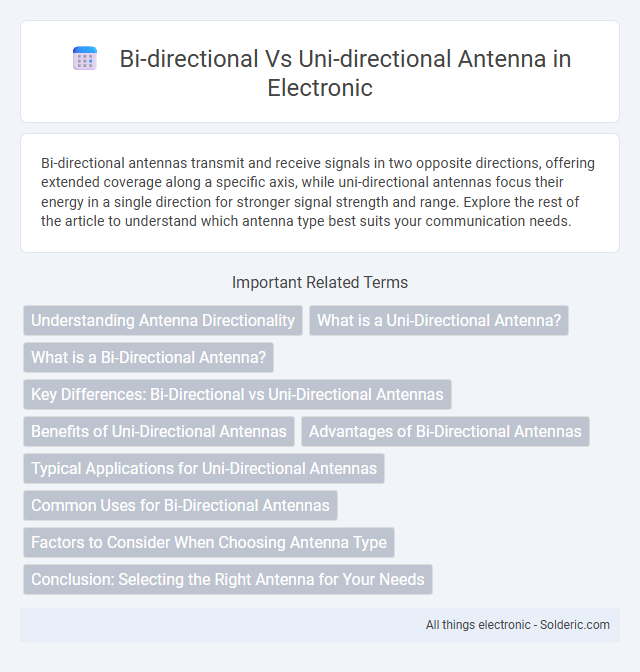Bi-directional antennas transmit and receive signals in two opposite directions, offering extended coverage along a specific axis, while uni-directional antennas focus their energy in a single direction for stronger signal strength and range. Explore the rest of the article to understand which antenna type best suits your communication needs.
Comparison Table
| Feature | Bi-Directional Antenna | Uni-Directional Antenna |
|---|---|---|
| Signal Coverage | Radiates signal in two opposite directions (180deg each) | Focuses signal in one direction (narrow beamwidth) |
| Use Case | Ideal for point-to-point links in two directions | Best for long-distance, point-to-point communication |
| Gain | Moderate gain (typically 6-9 dBi) | Higher gain (typically 9-15+ dBi) |
| Interference | Higher exposure to interference from two sides | Less interference due to focused pattern |
| Examples | Dipole antennas, Batwing antennas | Yagi antennas, Parabolic dish antennas |
Understanding Antenna Directionality
Bi-directional antennas transmit and receive signals in two opposite directions, enhancing coverage along a linear axis and optimizing signal strength in targeted areas. Uni-directional antennas focus energy in a single direction, maximizing gain and improving performance over longer distances. Understanding antenna directionality is crucial for selecting the appropriate antenna type based on coverage needs and signal propagation requirements.
What is a Uni-Directional Antenna?
A uni-directional antenna focuses its signal transmission and reception in a single direction, enhancing range and signal strength for targeted communication. Common types include Yagi, parabolic, and panel antennas, which efficiently direct electromagnetic waves to improve performance in point-to-point links. This focused beam reduces interference and signal loss, making uni-directional antennas ideal for applications requiring long-distance or directional connectivity.
What is a Bi-Directional Antenna?
A bi-directional antenna transmits and receives radio signals in two opposite directions along a single plane, typically horizontal or vertical. This design enhances signal coverage and efficiency for applications requiring targeted communication between two fixed points, such as point-to-point wireless links. Compared to uni-directional antennas, bi-directional antennas offer balanced radiation patterns that minimize interference and optimize signal quality in both directions.
Key Differences: Bi-Directional vs Uni-Directional Antennas
Bi-directional antennas transmit and receive signals in two opposite directions, providing broader coverage along a linear axis, which makes them ideal for corridors or long outdoor areas. Uni-directional antennas focus their signal in a single direction, resulting in higher gain and greater range, suitable for point-to-point communication or targeting specific areas. Key differences include coverage patterns, signal strength, and application scenarios where bi-directional antennas are preferred for wider area coverage, while uni-directional antennas excel in focused, long-distance communication.
Benefits of Uni-Directional Antennas
Uni-directional antennas concentrate signal strength in a single direction, enhancing range and signal quality for targeted communication. This focused transmission minimizes interference and improves performance in environments requiring long-distance or point-to-point connections. Their efficiency in directing energy reduces power consumption while maximizing effective coverage area compared to bi-directional antennas.
Advantages of Bi-Directional Antennas
Bi-directional antennas offer the advantage of providing signal coverage in two opposite directions, effectively doubling the communication range compared to uni-directional antennas in specific scenarios. They are ideal for applications like hallway or corridor coverage, where signals need to be transmitted or received in opposite directions without the need for multiple antennas. Your network can benefit from simplified installation and cost efficiency by utilizing bi-directional antennas for such targeted coverage areas.
Typical Applications for Uni-Directional Antennas
Uni-directional antennas are commonly used in applications such as point-to-point communication links, where a focused signal transmission is required to connect two specific locations. They are ideal for long-distance wireless communication, including microwave links, Wi-Fi hotspots, and cellular tower backhaul, ensuring stronger signal strength and reduced interference. Your network benefits from enhanced range and reliability by using a uni-directional antenna in environments demanding targeted coverage and minimal signal dispersion.
Common Uses for Bi-Directional Antennas
Bi-directional antennas are commonly used in point-to-point communication links, such as connecting two buildings or radio towers, where signal transmission and reception are required in two opposite directions. These antennas are ideal for applications like wireless backhaul, repeaters, and corridor coverage in large buildings or campuses. Your network can benefit from enhanced signal strength and improved coverage efficiency when utilizing bi-directional antennas in such scenarios.
Factors to Consider When Choosing Antenna Type
Choosing between a bi-directional and uni-directional antenna depends on your coverage needs, signal strength requirements, and environmental conditions. Bi-directional antennas are ideal for extending signals in two opposite directions, enhancing coverage in elongated areas, while uni-directional antennas focus energy in a single direction, providing higher gain and reduced interference. Consider factors such as the target area layout, potential obstacles, and interference sources to optimize your network performance effectively.
Conclusion: Selecting the Right Antenna for Your Needs
Choosing between bi-directional and uni-directional antennas depends on the specific coverage requirements and signal directionality. Bi-directional antennas provide coverage in two opposite directions, ideal for linking two distant points or extending range along a corridor. Uni-directional antennas focus signal strength in a single direction, enhancing performance and reducing interference for targeted communication.
bi-directional vs uni-directional antenna Infographic

 solderic.com
solderic.com